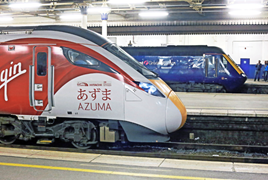The ‘387/2s’ replaced all but six of the 24 five-car Class 442s built in the late-1980s, but which were powered by traction equipment dating from the 1960s. The ‘442s’ subsequently went into store, with the remaining six due off-lease from GTR at the end of this month. Their fate is expected to be decided in the next few weeks, but they could be used by at least one franchise, while open access operators are also interested.
GTR’s introduction of the ‘387/2s’ was not without controversy, with drivers’ union ASLEF calling industrial action and refusing to drive 12-car ‘387/2s’ even though they were the same length as a ten-car ‘442’ and GTR ran identical 12-car Class 387/1s on its Thameslink route (which mirrors GatEx’s route from East Croydon southwards).
A handful of ‘387/2s’ were sub-leased from GatEx to fellow GTR operation Thameslink (TL) through the summer, to enable Class 319s to be withdrawn ahead of a transfer to Northern. That ended in late summer as new trains were delivered to TL.
Those new trains for TL were the Class 700s, the first of which was unveiled on May 24 (RAIL 802), and which entered traffic on June 18. Initially 12-car Class 700/1s entered traffic. Siemens builds the trains in Krefeld (Germany) and they are tested at Wildenrath before being dispatched through the Channel Tunnel to Three Bridges depot.
Between January 6 and November 30, 11 12-car trains (132 vehicles) and 20 eight-car trains (160 vehicles) had been delivered, with nearly all in passenger traffic. That equates to 85 four-car EMUs that the trains are designed to replace.
Currently eight-car trains are being delivered, and this will continue for the next few months. The introduction of one eight-car ‘700/0’ enables two four-car EMUs to be sent off-lease - currently GTR is removing its 29 four-car Class 387/1s from TL and moving them to its Great Northern operation. By December 9, GN had 20 ‘387/1s’, which in turn allowed older Class 321s to be sent off-lease.
The entire 1,140-vehicle Class 700 fleet, to be split into 55 12-car and 60 eight-car trains, will be delivered by the end of 2018. This will enable GTR to introduce the planned 24 trains per hour through the Thameslink ‘Core’ while linking Cambridge and Peterborough directly with the South Coast for the first time.
The third fleet to be introduced was the (initially) small fleet of Great Western Railway Class 387/1s (387130-387137). These were also built by Bombardier at Derby, and entered traffic on September 5. Owned by Porterbrook, they run in pairs from London Paddington to Hayes & Harlington.
The trains were ordered when FirstGroup won the new deal to run trains on the Great Western until 2019 (RAIL 770), and were (at the time) planned to be the only new Electrostars delivered for use in the Thames Valley, with the remaining trains cascaded from GTR. That did not happen, and so in the end GWR ordered a further 37 brand new ‘387/1s’, of which 387138-142 have so far been delivered for commissioning.
Further problems could lie ahead for this fleet in terms of where it can actually run. It is designed to operate on the Thames Valley routes and branches, but beyond Reading the wires will now not be erected to Oxford by 2020 (as had been planned), while branch electrification has also been deferred.
It is still hoped that the wires will be energised to (at least) Maidenhead by the summer. However, that means that to carry out planned maintenance of the ‘387s’ GWR will have to have them dragged by a diesel to Reading depot, where they are based.
The next batch of 14 to be delivered should allow more trains between London and Hayes & Harlington to become electrically-powered. But this will soon be a large fleet for a small operation (until more wires are energised), and the planned diesel multiple unit cascade westwards has been delayed as a result of the electrification woes. Nevertheless, the introduction of the ‘387/1s’ by GWR represents the first electric trains for the railway.
The other train fleet introduced - to much less fanfare - has been the six four-car Class 387/3s for c2c (387301-387306). Also built by Bombardier in Derby, these trains (along with 14 GWR ‘387s’) had been ordered speculatively by Porterbrook and subsequently snapped up by c2c. Used to boost capacity on core c2c lines, their introduction allows the operator to lengthen other services, while the ‘387/3s’ were introduced operating in eight and 12-car formations.
Other fleets have started to be delivered and unveiled ahead of their introductions.
The most eye-catching has probably been the Intercity Express Programme (IEP) Class 800s, with the first to be unveiled the nine-car Azuma for Virgin Trains East Coast.
The bi-mode train (800101) doesn’t enter traffic until 2018, and indeed VTEC has been unable to tell RAIL exactly what the introduction plan is, although it was first to unveil the trains with the ‘800/1’ running into London King’s Cross in March under its own power. It has subsequently been used for testing on both the East Coast and Great Western main lines, as well as reaching Plymouth. The train was manufactured by Hitachi in Kasado (Japan).
On June 30, to mark the 175th anniversary of the Great Western Railway reaching Bristol, GWR went one better with the ‘800s’ and operated the first passenger-carrying train on the UK network. Invited guests travelled from Reading to London Paddington on 800004, which operated using diesel engines.
GWR will be the first to introduce IEPs, with July 10 the planned date. Initially pairs of five-car ‘800/0s’ will be introduced between London Paddington and Bristol Temple Meads, operating for some of the way as electric trains and the rest as diesel trains. This means that the planned timetable improvements cannot be delivered.
Thirty-six ‘800/0s’ are on order for GWR. These will replace the High Speed Train fleet, which dates from 1976 and which is being cascaded to ScotRail from next year ready for a 2018 introduction.
The first IEP assembled in the UK at Newton Aycliffe was unveiled to the press on December 9, and this is also destined for GWR (800005).
















Login to comment
Comments
No comments have been made yet.